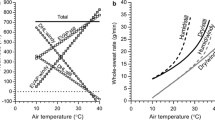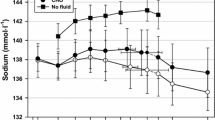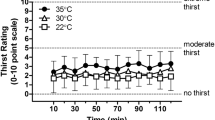Abstract
Eight endurance-trained cyclists rode as far as possible in 1 h on a stationary cycle simulator in a moderate environment (20°C, 60% relative humidity, 3 m·s−1 wind speed) while randomly receiving either no fluid (NF) or attempting to replace their approximate 1.71 sweat loss measured in a previous 1-h familiarisation performance ride at approximately 85% of peak oxygen uptake with artificially sweetened, coloured water (F). During F, the cyclists drank mean 1.49 (SEM 0.14)1 of which mean 0.27 (SEM 0.08)1 remained in the stomach at the end of exercise and mean 0.20 (SEM 0.05) 1 was urinated after the trial. Thus, only mean 1.02 (SEM 0.12)1 of the ingested fluid was available to replace sweat losses during the 1-h performance ride. That fluid decreased the mean average heart rate from 166 (SEM 3) to 157 (SEM 5) beats·min−1 (P < 0.0001) and reduced the final mean serum [Na−] and osmolalities from 143 (SEM 0.6) to 139 (SEM 0.6) matom·1−1(P < 0.005) and from 294 (SEM 1.7) to 290 (SEM 1.9) mosmol·1−1 (P = 0.05), respectively. Fluid ingestion did not significantly attenuate rises in plasma anti-diuretic hormone and angiotensin concentrations, or decrease the approximate-15% falls in estimated plasma volume in the F and NF trials. Nor did fluid ingestion significantly affect the approximate 1.71 · h−1 sweat rates, the rises in rectal temperature (from 36.6° to 38.3°C) or the ratings of perceived exertion in the two trials. Ingestion of approximately 1.51 of fluid produced an uncomfortable feeling of stomach fullness and reduced the mean distance covered in 1 h from 43.1 (SEM 0.7) to 42.3 (SEM 0.6) km (P < 0.05). Thus, trying to replace more than 1.01·h−1 sweat losses during high-intensity, short duration exercise in a moderate environment would not appear to induce beneficial physiological effects, and may impair exercise performance.
Similar content being viewed by others
References
Adolph EF (1947) Physiology of man in the desert. Interscience, New York
Barr SI, Costill DL, Fink WJ (1991) Fluid replacement during prolonged exercise: effects of water, saline or no fluid. Med Sci Sports Exerc 23:811–817
Bean WB, Eichna LW (1943) Performance in relation to environmental temperature. Reactions of normal young men to simulated desert environment. Fed Proc 2:144–158
Below PR, Coyle EF (1993) Fluid and carbohydrate ingestion individually benefit exercise lasting one-hour (abstract). Med Sci Sports Exerc [Suppl] 25:53
Borg G (1975) Simple rating methods for estimation of perceived exertion. In: Borg G (ed) Physical work and effort. Pergamon Press, New York, pp 39–46
Costill DL, Kammer WF, Fisher A (1970) Fluid ingestion during distance running. Arch Environ Health 21:520–525
Coyle EF, Hamilton M (1990) Fluid replacement during exercise: effects on physiological homeostasis and performance. In: Gisolfi CV, Lamb DR (eds) Perspectives in exercise science and sports medicine, vol. 3 Fluid homeostasis during exercise. Benchmark Press, Indianapolis, pp 281–303
Davis GR, Santa Ana CA, Mòrawski SG, Fordtran JS (1980) Development of a lavage solution associated with minimal water and electrolyte absorption or secretion. Gastroenterology 78:991–995
Dill DB, Costill DL (1977) Plasma volume changes followings exercise and thermal dehydration. J Appl Physiol 37:247–248
Eichna LW, Bean WB, Ashe WF, Nelson N (1945) Performance in relation to environmental temperature. Reactions of normal young men to hot, humid (simulated jungle) environment. Bull Johns Hopkins Hosp 76:25–58
Fordtran JS, Saltin B (1967) Gastric emptying and intestinal absorption during prolonged severe exercise. J Appl Physiol 23:331–335
Gray DA, Simon E (1983) Mammalian and avian anti-diuretic hormone: studies related to possible species variation in osmoregulatory systems. J Comp Physiol 151:241–246
Hainline A (1958) Haemoglobin, standard methods. Clin Chem 2:49–60
Hamilton MC, Gonzalez-Alonso J, Montain SJ, Coyle EF (1991) Fluid replacement and glucose infusion during exercise prevent cardiovascular drift. J Appl Physiol 71:871–877
Hawley JA, Noakes TD (1992) Peak power output predicts maximal oxygen uptake and performance time in trained cyclists. Eur J Appl Physiol 65:79–83
Heaps CL, Gonzalez-Alonso J, Coyle EF (1994) Hypohydration causes cardiovascular drift without reducing blood volume. Int J Sports Med 15:74–79
Montain SJ, Coyle EF (1992a) Fluid ingestion during exercise increases skin blood flow independent of increases in blood volume. J Appl Physiol 73:903–910
Montain SJ, Coyle EF (1992b) The influence of graded dehydration on hyperthermia and cardiovascular drift during exercise. J Appl Physiol 73:1340–1350
Noakes TD (1993) Fluid replacement during exercise. In:Holloszy JO (ed) Exercise and sports science reviews, vol 21. Williams and Wilkins, Baltimore, pp 297–330
Pitts GC, Johnson RC, Consolazio FC (1944) Work in the heat as affected by intake of water, salt and glucose. Am J Physiol 142:253–259
Pivarnik JM, Leeds EM, Wilkerson JE (1984) Effects of endurance exercise on metabolic water production and plasma volume. J Appl Physiol 56:613–618
Powers SK, Lawler J, Dodd S, Tulley R, Landry G, Wheeler K (1990) Fluid replacement drinks during high intensity exercise: effects on minimising exercise-induced disturbances in homeostasis. Eur J Appl Physiol 60:54–60
Pugh LG, Corbett JL, Johnson RH (1967) Rectal temperatures, weight losses, and sweat rates in marathon running. J Appl Physiol 23:347–352
Ramananthan NL (1964) A new weighting system for mean surface temperature of human body. J Appl Physiol 19:531
Rehrer NJ, Brouns F, Beckers EJ, Ten Hoor F, Saris WHM (1990) Gastric emptying with repeated drinking during running and bicycling. Int J Sports Med 11:238–243
Walsh RM, Noakes TD, Hawley JA, Dennis SC (1994) Impaired exercise performance time at low levels of dehydration. Int J Sports Med 15:392–398
Williams JH, Maher M, Jacobsen ED (1976) Relationship of mesenteric blood flow to intestinal absorption of carbohydrates. J Lab Clin Med 63:853–863
Author information
Authors and Affiliations
Rights and permissions
About this article
Cite this article
Robinson, T.A., Hawley, J.A., Palmer, G.S. et al. Water ingestion does not improve 1-h cycling performance in moderate ambient temperatures. Europ. J. Appl. Physiol. 71, 153–160 (1995). https://doi.org/10.1007/BF00854973
Accepted:
Issue Date:
DOI: https://doi.org/10.1007/BF00854973




